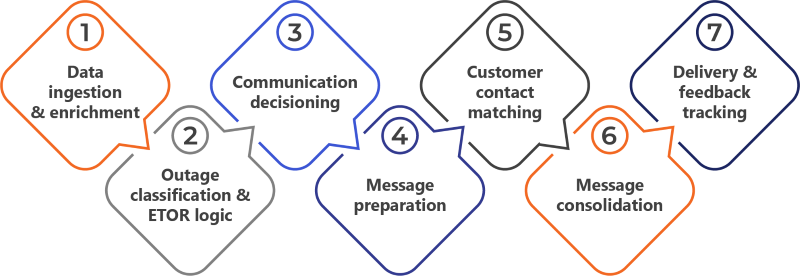Snapshot
A major utility set out to overhaul how it communicates with customers during service outages. The organization faced increasing regulatory pressure, heightened wildfire risk, and rising customer expectations for how information surrounding outages—planned, unplanned, and public safety power shutoffs (PSPS)—is communicated.
The organization had long relied on manual, file-based processes to manage outage communications, which limited its ability to act, scale, and monitor message delivery and impact. They partnered with Logic20/20 to implement an automated, rules-driven customer notification platform built in Palantir Foundry. The solution enables real-time processing of outage data, supports complex decision logic, and unifies communications across outage types, resulting in reduced costs, improved operational efficiency, and strengthened customer trust.
We brought our expertise and experience in:
- Data pipeline design in Palantir Foundry
- Real-time notification architecture
- High-reliability system design
- Machine learning for event forecasting
- Business rules automation
- Regulatory reporting enablement
- Integration strategy and vendor coordination
Powering millions of customers across a wildfire-prone region
Our client is one of the largest investor-owned utilities in the western United States, delivering electricity to millions of customers across a vast and environmentally diverse service area. Operating in a wildfire-prone region under stringent regulatory oversight, the utility is working to modernize its infrastructure, improve operational resilience, and enhance public safety.
Fragmented systems, rising expectations
The utility had historically relied on a set of disconnected, manual processes to notify customers about outages. Information flowed through batch file transfers—often involving large CSV files manually uploaded to external systems—which slowed delivery and limited visibility into whether messages were successfully sent or received.
Each type of outage—planned, unplanned, and PSPS—operated through its own communication pathway, leading to duplicate messages, inconsistent timing, and multiple points of failure. Critical logic such as customer contact preferences, outage classifications, and event timing was scattered across systems, making it difficult to ensure consistency or compliance.
Internal teams had limited ability to monitor communication outcomes and trace delivery results back to source systems. Regulatory reporting required significant manual effort. As customer expectations for timely, transparent communication continued to rise, the utility recognized that its legacy tools couldn’t keep pace.
Building a unified platform for timely, rules-driven communication
Logic20/20 partnered with the utility to design and implement a customer communications management solution that is comprehensive of all scenarios, appropriately automated and scalable. Built in Palantir Foundry, the solution replaces fragmented legacy systems with a single-platform solution that brings together real-time data, structured business logic, and customer preferences.
At the core of the solution is a seven-stage pipeline that automates every step of the notification process—from initial outage ingestion to message delivery and feedback tracking. The system continuously evaluates incoming outage data, classifies each event, determines the appropriate communication based on outage type and customer preferences, and sends targeted notifications through multiple communication channels (e.g. SMS, email).
A key feature of the solution is its ability to determine and deliver an estimated time of restoration (ETOR) for each affected customer. If, during an outage event, the field crews are able to provide ETORs within a defined timeframe, that information is included in customer messages. If no estimate is available, the solution draws on a machine learning model trained on outage history, time of year, location, and other contextual factors to generate a predictive ETOR.
The solution incorporates specific business rules for PSPS, ensuring communications align with regulatory requirements and internal safety protocols. Smart suppression logic prevents unnecessary or mistimed messages, and automated filtering helps tailor messages to the unique context of each customer. When manual intervention is needed, teams use a combination of Foundry-based tools—including fusion sheets for event-specific message suppression and a front-end application for cancelling pre-event communications if a planned outage is called off.
To support operational visibility, Logic20/20 also developed dashboards that track communication delivery, opt-out rates, and data quality concerns. These tools help internal teams manage outreach and identify delivery issues early.
Logic20/20’s team worked closely with both technical stakeholders and business owners to ensure every component of the system reflected operational realities, regulatory expectations, and the customer experience on the ground. The solution also consolidated previously siloed logic for each outage type, enabling long-term maintainability and supporting the utility’s upcoming transition from DMS (distribution management system) to ADMS (advanced distribution management system).
7-stage processing pipeline for outage communications

The results: Smarter systems, stronger performance
Faster, more targeted communications
The new solution has significantly improved the speed, accuracy, and reliability of outage-related communications. Notifications that once required manual coordination across multiple systems are now generated and delivered promptly—typically within 5 to 10 minutes of outage creation.
Enhanced customer experiences
Customers now receive more timely messages tailored to their location and outage type. The inclusion of ETORs helps them make informed decisions, such as whether to relocate, adjust business operations, or plan around the outage. This responsiveness has played a key role in reducing frustration, particularly during unplanned outages, by helping customers anticipate and prepare for service disruptions. Additional customer benefits include the following:
- Vulnerable customers—such as individuals with medical needs and businesses with perishable inventory—receive the information they need to take protective action.
- Caregivers and family members can subscribe to alerts on behalf of others to stay informed and offer support.
- All customers benefit from reliable communications that build trust in their utility.
Stronger operational coordination
The solution also helped the utility surface previously hidden process gaps—such as premature or delayed notifications caused by timing mismatches between field activity and system updates. These insights led to tangible improvements in how field crews and operations teams coordinate and communicate. Planned outage workflows were also streamlined, with automation replacing manual steps for activation and cancellation, reducing errors and keeping crews aligned on the most up-to-date information.
Greater visibility and control
Operational teams now benefit from systemwide visibility into messaging activity and delivery performance. Greater transparency has accelerated the identification and resolution of communication issues and reduced the time and effort required for compliance reporting. Internal teams can now work from a shared source of truth—supporting more consistent, auditable communications across the organization. The consolidation also reduced external vendor complexity and improved the utility’s ability to manage service-level agreements (SLAs) and messaging costs across outage types.
Advancing the utility’s digital strategy
The project not only delivered immediate operational gains, but also positioned the utility to advance its digital strategy with greater agility and confidence.
A foundation for future resilience
By building a flexible, forward-looking solution for outage communications, the utility positioned itself to adapt as both technology and customer expectations continue to evolve. The system’s unified design and real-time capabilities addressed immediate challenges while creating space for innovation, enabling the organization to deliver a more connected, resilient experience for customers and internal teams alike. The project also helped shift the utility’s approach to technology, supporting faster iteration, stronger team alignment, and a more agile response to future demands.

